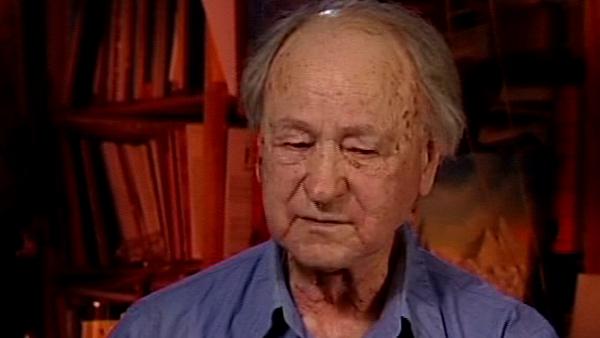NEXT STORY

The importance of film preservation for future generations
RELATED STORIES

NEXT STORY

The importance of film preservation for future generations
RELATED STORIES


|
Views | Duration | |
|---|---|---|---|
| 91. The Film-Makers' Cinematheque | 205 | 05:37 | |
| 92. Founding Anthology Film Archives | 54 | 03:26 | |
| 93. Losing funding for Anthology Film Archives | 38 | 03:55 | |
| 94. Building up the Anthology Film Archives | 40 | 04:05 | |
| 95. Our headquarters at 80 Wooster Street | 74 | 03:15 | |
| 96. The constant need for more space in Anthology Film Archives | 30 | 03:16 | |
| 97. The importance of film preservation for future generations | 39 | 02:34 | |
| 98. Running Anthology Film Archives | 43 | 01:40 | |
| 99. Raising funds for all the essential projects | 32 | 03:48 | |
| 100. Film-making processes | 65 | 05:54 |


One of the reasons why I went looking for the larger and different space was that on 80 Wooster Street, during that period, our film collection grew and our... our book and periodicals, the library, paper materials library grew and the space was very... very minimal. Projection space was okay, but we had no other space for anything else. So I thought we have to get a larger space. That's when I noticed that the building on the corner of 2nd Avenue and 2nd Street, the courthouse, old courthouse building, was still there and owned by the city and I went after it and then on auction – that's another long story – we purchased it and we moved and transferred all the... because it is a much larger space. Larger, quite large but by now and now when I'm talking were in 2003, in the fall, it's too small already for us because since the coming of video film labs began closing, going bankrupt. They had no work and abandoning all the films and materials which most of them were independent productions and we dragged them into our building and we're still dragging them and there is no more space and then... then as time goes, various film collectors die and they leave their collections to us. Film scholars die like Louise Jacobs for instance, J Layder, and they leave large amounts of very important paper materials and they're all... I mean, like a history of the last 50, 60 years of American cinema. As it is now they're not available to any scholars. They're in boxes, so we are now, you know, to accommodate and make them available. We are in the process of building a library like an additional structure next to the current building. And that will take all the paper materials. So, it's constant...
[Q] And is your... I mean, is this...?
After that when I finish the library I will go to Himalayas.
Jonas Mekas (1922-2019), Lithuanian-born poet, philosopher and film-maker, set up film collectives, the Anthology Film Archive, published filmzines and made hundreds of films, all contributing to his title as 'the godfather of American avant-garde cinema'. He emigrated to America after escaping from a forced labour camp in Germany in 1945.
Title: The constant need for more space in Anthology Film Archives
Listeners: Amy Taubin
Amy Taubin is a contributing editor for "Film Comment" magazine and "Sight and Sound" magazine. Her book, "Taxi Driver", was published in 2000 in the British Film Institute's Film Classics series. Her chapter on "America: The Modern Era" is part of "The Critics Choice" published by Billboard Press, 2001, and her critical essays are included in many anthologies, mostly recently in "Frank Films: The Film and Video Work of Robert Frank" published by Scalo.
She wrote for "The Village Voice" weekly from 1987 into 2001 both as a film and a television critic. She also wrote a column for the "Village Voice" titled "Art and Industry" which covered American independent filmmaking. Her first weekly film criticism job was at the "SoHo Weekly News". Her writing has also appeared in "Art Forum", the "New York Times", the "New York Daily News", the "LA Weekly", "Millennium Film Journal", "US Harpers Bazaar" and many other magazines. She is a member of the National Society of Film Critics and the New York Film Critics Online.
She started her professional life as an actress, appearing most notably on Broadway in "The Prime of Miss Jean Brodie", and in avant-garde films, among them Michael Snow's "Wavelength", Andy Warhol's "Couch", and Jonas Mekas' "Diaries, Notebooks and Sketches".
Her own avant-garde film, "In the Bag" (1981) is in the collection of the Museum of Modern Art and the Friends of Young Cinema Archives in Berlin.
She was the video and film curator of "The Kitchen" from 1983-1987.
She has a B.A. from Sarah Lawrence College and an M.A. from N.Y.U. in cinema studies. She teaches at the School of Visual Arts in both the undergraduate and the MFA graduate programs, and lectures frequently at museums, media centers, and academic institutions. In 2003, she received the School of Visual Arts' art historian teaching award.
Tags: Louise Jacobs
Duration: 3 minutes, 17 seconds
Date story recorded: September 2003
Date story went live: 29 September 2010